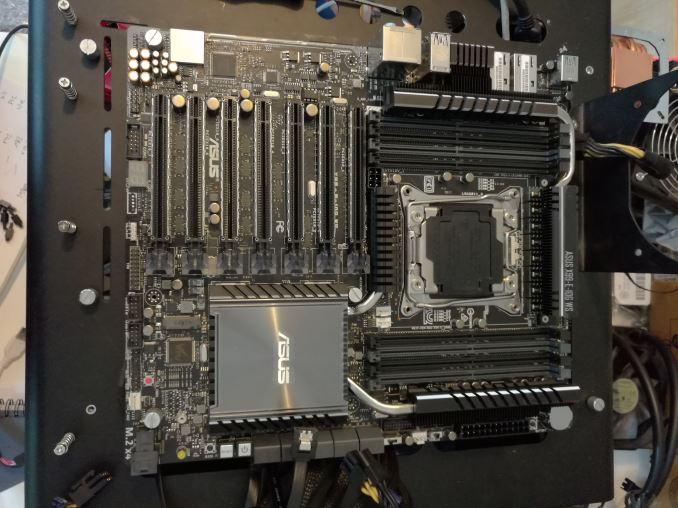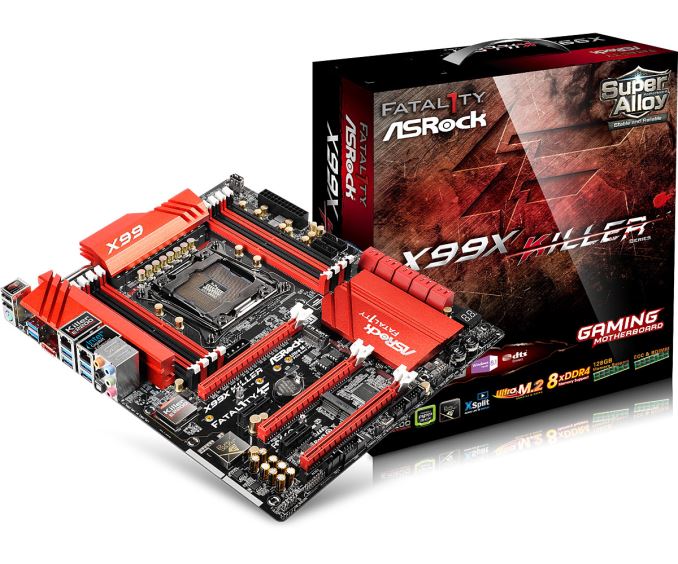The Intel Broadwell-E Review: Core i7-6950X, i7-6900K, i7-6850K and i7-6800K Tested
by Ian Cutress on May 31, 2016 2:01 AM EST- Posted in
- CPUs
- Intel
- Enterprise
- Prosumer
- X99
- 14nm
- Broadwell-E
- HEDT
The Market
At this point in time, Intel is primarily competing with itself. Because the enterprise market requires consistency, the HEDT platform is constrained to that three year, two product cycle, which maintains enough consistency in socket compatibility to keep the enterprise partners happy. When Intel has 95%+ of the HEDT and x86 enterprise market, rather than increasing market share to generate revenue, Intel has to convince users on older systems that their new products are worth the investment. That’s an easy sell in the enterprise market, as time is money and total cost of ownership for a system is typically well documented for cyclical updates.
For HEDT, making that case to prosumers can be difficult. It depends on budgets and how applications are developing, especially when a number of popular professional software packages are (where possible) trying to leverage PCIe accelerators. There will always be a strong market for CPU performance, and there will always be a market for HEDT, depending on the price. But at some point the HEDT and Xeon markets do collide, and the two main factors on this are price and availability.
As mentioned earlier, the newly introduced Broadwell-E Core i7 parts collide in price with a number of Broadwell-EP Xeon parts, which could suggest that Intel wants to push potential prosumers (especially the professional ones) more into systems made by enterprise and workstation partners. These systems are typically sold with appropriate support, and the two platforms differ by a few features. The question becomes about who is buying HEDT: a number of users reading this will be gamers, and will not be interested in workstation sellers.
It’s a strange balance that Intel is trying to strike. Everyone wants more – whether they need it or not is a different conversation – but most enthusiasts say they want more. Intel states that as a company, it supports the gamers and the enthusiasts who want to push their consumer platforms to the fullest, and something like Broadwell-E does that. However a prohibitive price might reduce the potential number of next generation enthusiasts who want to play at the high-end.
X99 Refresh Motherboards
Throughout this month many of the regular motherboard manufacturers have either released, announced, or teased newer "refresh" motherboards using the LGA2011-3 socket and the X99 chipset. We’ve got a base roundup of all the new motherboards coming out of Computex planned, especially as new models are being announced and shown at the show. A couple of these landed on our desk for Broadwell-E testing, such as the MSI X99A Gaming Pro Carbon:
The Carbon is a relatively new brand for MSI’s motherboard range, typically on the high-end models, and this one aims for a deep black aesthetic that is enhanced through the additional LED lighting.
We also have in the ASUS X99-E-10G WS motherboard, ASUS’ high-end workstation and prosumer based motherboard that also integrates an Intel X550-T2 10 gigabit Ethernet chip offering two 10GBase-T ports. We’ve seen this before on the ASRock X99 WS-E/10G, which used the X540-T2, and required eight PCIe 3.0 lanes from the CPU to provide enough bandwidth. We were only able to test the ASUS 10G board for a couple of days before leaving for Computex, and will have a preview up shortly.
ASRock also sent us their X99X Killer, although the courier tried to deliver on a day where I spent 30 minutes gathering stuff for the Computex trip. Go figure. It’ll be ready to test when I get back!
This Review
As with every CPU launch, there are a number of different directions to take our review. In our review of the launch of the consumer Broadwell parts, the i7-5775C and the i5-5675C we examined the generational update over previous architectures, and thus won’t repeat those tests here. We have had almost every high-end desktop CPU since Sandy Bridge-E in-house at some point, although only the latest have been through our most recent benchmark suite. Due to timing, we were able to test all four of the new Broadwell-E processors, and retest the three Haswell-E processors, however we have a more limited dataset for comparison to Ivy Bridge-E, Sandy Bridge-E and Nehalem/Westmere. It will be interesting to see how the CPU performance for the HEDT has adjusted over the last five generations.
The other angle is the recent release of Intel’s Skylake mainstream focused processors, such as the i7-6700K and the i5-6600K, which feature a higher single core frequency but fewer cores and fewer memory channels, or the mainstream enthusiast focused Devil’s Canyon processors released back in July 2014. These have been tested on our latest range of benchmarks, and should make it clear where the latest mainstream-to-HEDT crossover should be.
Test Setup
| Test Setup | |
| Processor | Intel Core i7-6950X (10C/20T, 3.0-3.5 GHz) Intel Core i7-6900K (8C/16T, 3.2-3.7 GHz) Intel Core i7-6850K (6C/12T, 3.6-3.8 GHz) Intel Core i7-6800K (6C/12T, 3.4-3.6 GHz, 28 PCIe 3.0) |
| Motherboards | MSI X99A Gaming Pro Carbon |
| Cooling | Cooler Master Nepton 140XL |
| Power Supply | OCZ 1250W Gold ZX Series Corsair AX1200i Platinum PSU |
| Memory | G.Skill RipjawsX DDR4-2400 C15 4x16GB 1.2V |
| Memory Settings | JEDEC @ 2400 |
| Video Cards | ASUS GTX 980 Strix 4GB MSI R9 290X Gaming 4G MSI GTX 770 Lightning 2GB MSI R9 285 Gaming 2G ASUS R7 240 2GB |
| Hard Drive | Crucial MX200 1TB |
| Optical Drive | LG GH22NS50 |
| Case | Open Test Bed |
| Operating System | Windows 7 64-bit SP1 |
Many thanks to...
We must thank the following companies for kindly providing hardware for our test bed:
Thank you to AMD for providing us with the R9 290X 4GB GPUs.
Thank you to ASUS for providing us with GTX 980 Strix GPUs and the R7 240 DDR3 GPU.
Thank you to ASRock and ASUS for providing us with some IO testing kit.
Thank you to Cooler Master for providing us with Nepton 140XL CLCs.
Thank you to Corsair for providing us with an AX1200i PSU.
Thank you to Crucial for providing us with MX200 SSDs.
Thank you to G.Skill and Corsair for providing us with memory.
Thank you to MSI for providing us with the GTX 770 Lightning GPUs.
Thank you to OCZ for providing us with PSUs.
Thank you to Rosewill for providing us with PSUs and RK-9100 keyboards.













205 Comments
View All Comments
sor - Sunday, June 5, 2016 - link
Actually, without those benchmarks I wouldn't have known for sure that we were GPU limited or that CPU makes almost NO difference (I might have expected a few more FPS). I also found it interesting that one game stood out as being CPU limited.IUU - Sunday, June 5, 2016 - link
All good and awesome but Intel's persistence on maintaining many-core cpus as niche expensiveproducts is a dangerous strategy, that may ultimately lead to its downfall.
If the IT world would like to see a renewed growth, high performance computing should enter the lives of ordinary Joes. Plenty of apps could make their way into our lives via many-core cpus.
Games with really improved AI, local voice and image recognition, reading comprehension, advanced text editing, advanced 3d printing, etc etc.
Looking down on the needs of ordinary people, is nonsensical, for it is "simple joes", the needs of which led to many core cpus and advanced gpus,that the hpc world so much uses. No further development can come if the same old strategy is not applied.
Motion2082 - Monday, June 6, 2016 - link
What other XEONs would you recommend for 8 core?craveable - Tuesday, June 7, 2016 - link
Seriously, guys. My personal opinion is to skip Broadwell-E, unless you absolutely cannot wait till Q1 2017. It's a very realistic timeframe when Skylake-E will be released. Some journalist spotted a Gigabyte motherboard on Computex 2016, suited for Skylake-E, sporting a new LGA 3647 socket and 6-channel memory controller. Memory bandwidth was always a crucial selling point of HEDT CPUs, so a transition from 4 (current) to 6 (Skylake-E) is an important incremental update.craveable - Tuesday, June 7, 2016 - link
However, further studying of leaks reveled that the next HEDT will be released in Q2 2017 and be probably named Skylake-X. In the leaked roadmap the Skylake-X availability timeframe is strangely the same as for Kaby Lake-X.craveable - Wednesday, June 8, 2016 - link
However #2, it's likely, that only server part of Skylake (EP) will get LGA 3647 and 6-channel controller. And Skylake-X will get 4 channels and the same LGA 2011-3.galta - Wednesday, June 8, 2016 - link
There is no point in saying that someone should skip upgrading. But for budget constraints, if your processor is not good enough, you have to upgrade; if it still performs as you need, you do not need to upgrade, even if new generation has the same price and 50% more performance.It is said that Intel is trying to milk us with a +USD1,700 cpu and that not all softwares (games) are fully optimized for more than 2-4 cores, but if you still run a i7 9xx series, it is probably time to upgrade, even if Broadwell-E increase in performance is not huge.
mapesdhs - Thursday, June 9, 2016 - link
That makes no sense. You state that BW-E performance increase isn't that much, while saying someone with an X58 6c should still upgrade anyway. What for? Why would someone on a constrained budget spend so much for so little speed gain? Given the platform differences, X58 users would probably benefit more from newer storage tech such as M2 and newer USB3x, in which case a 5930K on a decent board would be more sensible (or a 5820K if they don't need the PCIe lanes). What you've suggested just sounds like upgrading for its own sake. These days there are far more nuanced options available, especially from the used market.fifa17 - Sunday, June 12, 2016 - link
I'm putting a system together and I'm stuck between Core i7-6850K and Core i7-6800K on a ROG STRIX X99 GAMING motherboard. The only confusing point is the number of PCI Express Lanes which is 28 for i7-6800K and 40 for the other. I've pre ordered the ASUS ROG Strix GeForce® GTX 1080 and don't plan on adding a second one in the future. I'm also not getting an optical drive of any sort and no HDDs. Just a 1TB Samsung 850 PRO SSD. Which CPU should I choose? Any ideas about these components?legolasyiu - Wednesday, June 29, 2016 - link
It will be best to get Core i7 6850 with 40 lanes for GTX 1080 16x with 850 Pro.